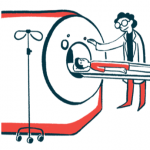Lesions in 3 Brain Regions Can Help Distinguish MS From Like Disorders
Written by |

People with multiple sclerosis (MS) are more likely to have lesions in three regions of the brain — the anterior temporal horn, periventricular region, and cerebellar hemisphere — compared with people with other inflammatory brain diseases, a study reports.
Looking for lesions in these parts of the brain may offer a “practical” way to distinguish MS from similar disorders, its researchers said.
The study, “Development and validation of a simple and practical method for differentiating MS from other neuroinflammatory disorders based on lesion distribution on brain MRI,” was published in the Journal of Clinical Neuroscience.
MS is characterized by inflammation that causes damage in the brain, which can be visualized as lesions on MRI scans.
Other diseases, including neuromyelitis optica spectrum disorder (NMOSD) and MOG antibody-associated disorder (MOGAD), also are characterized by inflammation and damage in the brain, and may give rise to some of the same symptoms and lesions typical of MS.
However, their underlying causes and treatment approaches differ — in fact, some treatments used in MS can make NMOSD or MOGAD worse — so correctly distinguishing between these conditions and MS is vital.
Scientists at New York University Grossman School of Medicine set out to create a simple method that could be used to discriminate between MS and NMOSD or MOGAD based on MRI imaging, specifically looking at the locations of brain lesions.
The team began by analyzing brain scans from 51 people with MS, 23 with NMOSD, and eight with MOGAD.
Results showed that, compared with NMOSD or MOGAD patients, those with MS were significantly more likely to have lesions in the anterior temporal horn — part of a larger brain region involved in learning and memory — and in the cerebellar hemisphere, which is involved in coordination. MS patients also were more likely to have a particular pattern of damage dubbed “Dawson’s fingers” in the periventricular region of the brain.
Statistical analyses showed that lesions in these three regions could differentiate between MS and the other conditions with a sensitivity (true-positive rate) of 87.1% and specificity (true-negative rate) of 72.5%.
Researchers then attempted to validate these results in a separate group of patients — 51 with MS, 25 with NMOSD, and 21 with MOGAD.
Again, MS patients were significantly more likely to have lesions in the anterior temporal horn, periventricular region, and cerebellar hemisphere. The researchers noted that all of the MS patients had lesions in at least one of these locations. The overall accuracy of differentiating MS from non-MS based on lesions in these regions was 76.3%.
“We developed and validated a practical predictive model for differentiating MS from NMOSD/MOGAD with 76% accuracy using the presence or absence of lesions in only three locations on brain MRI as predictor variables: cerebellar hemisphere, anterior temporal horn, and periventricular white matter in ‘Dawson’s finger’ orientation,” the researchers concluded.
The team noted that this model would be straightforward to apply in clinical practice, requiring a clinician to read a conventional MRI scan and determine the location of lesions, without a need for advanced MRI technology or analytical software.
“Our method for predicting MS versus other neuroinflammatory diseases based on lesion location in three white matter areas does not require advanced post-processing software or specialized sequences and can be readily applied in the real-world setting for training and clinical practice,” they wrote.
Researchers also noted their study was fairly small, and demographic differences among the disease groups may have influenced its results. They stressed that further research is needed to confirm and expand on these findings.






